Saint Therese of the Child Jesus
of the Holy Face
Entries by Maureen O'Riordan (555)
Letters from St. Therese's Sister Pauline, Mother Agnes of Jesus, to Sister Stanislaus of the Blessed Sacrament, "Philadelphia's LIttle Flower" - Part 2 - September 1, 2014
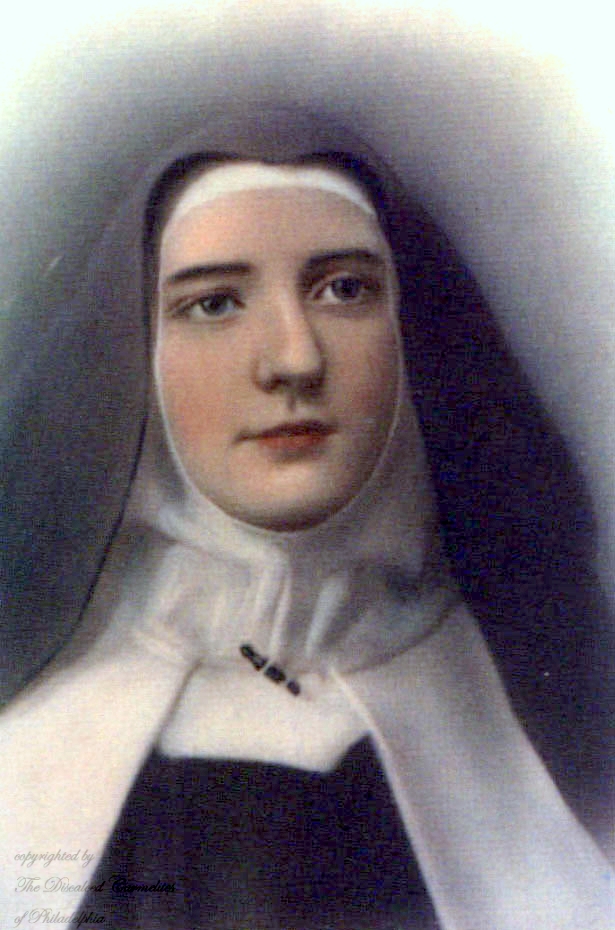 Sister Stanislaus of the Blessed Sacrament, O.C.D.
Sister Stanislaus of the Blessed Sacrament, O.C.D.
Read part one of "Sister Stanislaus of the Blessed Sacrament."
On July 25, 1902, Sister Stanislaus of the Blessed Sacrament rode a train from Boston to her native city, Philadelphia. She was accompanied by two other young women from Philadelphia who, like her, had been parishioners at the Church of the Gesu and were educated by the Sisters of Notre Dame de Namur: Sister Mary of St. Joseph and Sister Xavier of the Angels. With them was their new prioress, Mother Gertrude of the Heart of Jesus, who came from a family in New York City, but she had been educated at the Academy of the Holy Child at Sharon Hill in the Philadelphia suburbs. These four young women came to be known as "the four foundresses." Mother Beatrix of the Holy Spirit, prioress of the Boston Carmel,accompanied them to the temporary monastery at 1518 Poplar Street, the fifth Carmel founded in the United States.
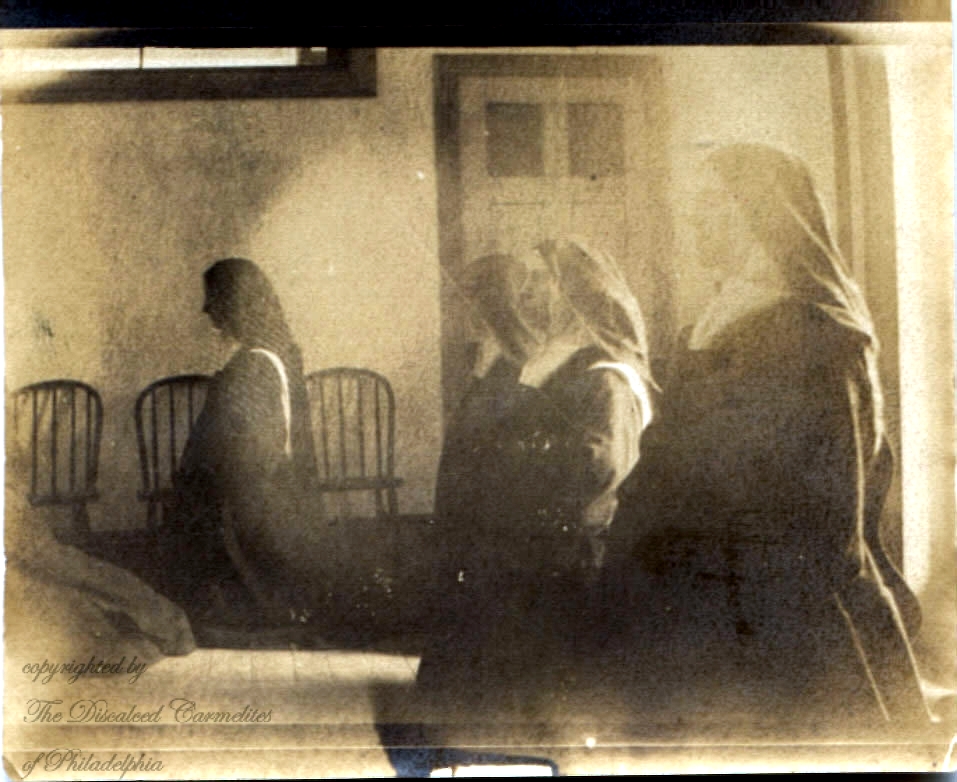 The four foundresses in the chapel of the Poplar Street houseThe next day Archbishop John Patrick Ryan offered the first Mass at the new foundation. For three days, before the enclosure was sealed, the young nuns held "open house" at Poplar Street. Many guests visited, among them the future St. Katharine Drexel and her sister, Louise Morrell; the latter made a generous donation on the spot and contributed generously to the monastery every month for the rest of her long life.
The four foundresses in the chapel of the Poplar Street houseThe next day Archbishop John Patrick Ryan offered the first Mass at the new foundation. For three days, before the enclosure was sealed, the young nuns held "open house" at Poplar Street. Many guests visited, among them the future St. Katharine Drexel and her sister, Louise Morrell; the latter made a generous donation on the spot and contributed generously to the monastery every month for the rest of her long life. 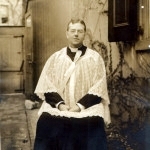 Father John J. Moore, first chaplain of the Philadelphia Carmel
Father John J. Moore, first chaplain of the Philadelphia Carmel
Father John J. Moore was assigned to be the nuns' chaplain. Together with Sister Mary, Sister Stanislaus was assigned as portress, the nun who answered the "turn" and communicated with the faithful seeking prayers, with other guests, and with workmen. The two portresses seized every opportunity to tell the people about St. Therese, then called "The Little Flower." Sister Stanislaus was also infirmarian (nurse) for the little community and was the first "councilor" (nun who advised the prioress). From 1902 she was already in correspondence with St. Therese's sister Pauline (Mother Agnes of Jesus, prioress of the Lisieux Carmel). We may imagine her working hard to spread devotion to St. Therese during the years in which she wrote to Mother Agnes and received the letters described below.
The first letter to Sister Stanislaus from Mother Agnes that survives at Philadelphia is dated May 1, 1903. Mother Agnes refers to the increasing persecution of the Church by the French government and writes that the Lisieux Carmelites expect to be evicted from their monastery, as many other religious communities had been. Mother Agnes mentions that she has been prioress for a year, ever since Mother Gonzague completed two six year-terms "and it was impossible, unfortunately, to re-elect her." She thanks Sister Stanislaus for her account of the good done by rose petals touched to Sister Therese's grave which she had sent to Philadelphia, and says "This is happening everywhere." At this time no proceedings had been opened for Sister Therese; indeed, it was in this year of 1903 that the Scots Father Thomas Taylor, visiting the Lisieux Carmel, was the first to suggest the idea that Sister Therese should be beatified.
The second letter, July 17, 1903, shows that Sister Stanislaus had asked permission to translate and publish a book about St. Therese. Mother Agnes regrets that she can't take the right from her London publishers. She describes the persecution again and rejoices at the graces (of which Sister Stanislaus has told her) being received by the friends of Sister Therese in the United States. Mother Agnes's language suggests that Sister Stanislaus had asked to see the unpublished writings of Sister Therese:
. . . desire no longer to understand pages that you will only be able to read in heaven. Ah, my dear little child, let us write like this: let us leave all the pages of our own lives to be read only in heaven. Do not regret anything. Thérèse will have you taste all of her secrets later on. You will be together forever in the garden of heaven.
In Mother Agnes's third letter, October 9, 1903, she said she has sent to Philadelphia some rose petals touched to the grave of Sister Therese. She expresses her anguish at the illness of Sister Marie of the Eucharist, her cousin Marie Guerin, who is suffering from tuberculosis (though Mother Agnes does not disclose the disease here), and says that the illness had been kept private till now. (Sister Marie of the Eucharist would die in April 1905). She tells Sister Stanislaus where to write for a catalog of French books about St. Therese. Mother Agnes remarks that Sister Genevieve (Celine) has completed the drawing of Therese at the feet of the Holy Father, which will appear in the next edition of Story of a Soul.
On December 8, 1903, Mother Agnes wrote again, promising the prayers of her Carmelites for Mother Gertrude, who is in poor health and for whom Sister Stanislaus is caring. She writes about a pamphlet being printed in English about Sister Therese, which is to be sent to Philadelphia and says that her cousin, Sister Marie of the Eucharist, is better.
On November 23, 1904, the Philadelphia Carmel moves to a larger temporary home on the southwest corner of 44st and Spruce Streets. During the Christmas holidays, on December 29, 1904, Mother Agnes writes again, sending the account of the life of Mother Marie de Gonzague, Therese's prioress, who had just died on December 17, 1904. Mother Agnes adds "let us not be saddened too much over the death of saints." She reports that Sister Marie of the Eucharist (Marie Guerin) is stil very ill.
No letters survive from 1905. On January 6, 1906, Mother Agnes writes to Mother Gertrude in answer to a letter from Mother Gertrude. She refers again to the rising persecutions. The French government was inventorying the property of religious communities with the intention of seizing it. Mother Agnes thanks Mother Gertrude for telling her about the graces St. Therese has obtained for her and for other members of the Philadelphia Carmel:
“Oh, how this angel loves and blesses your monastery! Rather, it is quite right that she reserve for it her most beautiful roses: love and confidence in God . . . .
Our community is very honored to feel itself so united to your dear ones, my Reverend Mother.”
sister Stanislaus receives a letter Mother Agnes wrote on March 2, 1906. Answering a question from Sister Stanislaus, encourages her “to love holy pleasures.” She says
“I love our Carmel [Philadelphia] very much, my little child, and as I write to you feel as much at ease as if I were speaking to one of my daughters.”
She refers to the increasing persecution in France and to how much God is offended. Mother Agnes informs Sister Stanislaus that the Holy Father (Pius X) attached many indulgences to an image of the Holy Face painted by Celine (Sister Genevieve) and attached an indulgence to a prayer to the Holy Face written by St. Therese. She says that the image and the prayer will be included in the 1906 edition of Story of a Soul.
Mother Agnes wrote again on August 8, 1906. Sister Stanislaus, now aged 27, was ill at the time. She worked very hard, once trying to fulfill her duties with a temperature of 103. Mother Agnes expressed sympathy.
My dear little Sister and child, let us always live well-united in Jesus and let us not cease to abandon ourselves to Him. Let us trust His Heart; this touches Him and so inclines Him to give us all that His Divine Heart contains. Oh, then how rich we shall be! How many roses to sprinkle over all the earth!
Mother Agnes’s postscript refers to a visit from Miss Pauline Wilcox, a writer, a friend and benefactor of the Philadelphia Carmel who had visited Lisieux in this year of 1906.
On December 12, 1906, Mother Agnes wrote Sister Stanislaus reporting that on that day the public chapel of the Carmel has been closed. The notes state:
2 During the storm of persecution, The Bishop of Bayeux ordered the closing of the chapels of all monasteries in his Diocese during the week of December 9. The Carmel of Lisieux, however, remained where it was and the religious were never required to leave. The public chapel of the Carmel was re-opened in 1907.
Mother Agnes does not know much longer the French government will allow the nuns to remain at Lisieux, and she asks Sister Stanislaus to address her letters to Isidore Guerin, the uncle of the Martin sisters, at Lisieux. She mentions the possibility of the community’s leaving in April 1907. She encloses a souvenir of a “blessed martyr” (perhaps a holy card, unknown) and speaks of the beautiful celebrations that have taken place in the Carmel’s chapel. (These could have been for December 8, Feast of the Immaculate Conception, or perhaps for October 15 for St. Teresa of Avila). Mother Agnes regrets that “they were the last ones, alas, for a long time” (now that the chapel is closed to the public).
Mother Agnes encloses a poem she herself has written “in reparation” and says it is being sold at Paris. She encloses an image of “The Flight into Egypt” with a poem by Therese. (We do not know which poem).
No letters from Mother Agnes to Sister Stanislaus survive from 1907 or 1908. But on January 4, 1909, Mother Agnes writes to Sister Stanislaus a letter of spiritual counsel:
Do not say that you are far from walking in the path of childhood, because you are walking there; I assure you of it in the name of Thérèse. Let your little heart of a child, therefore, be all joy and confidence! Do not tremble over your miseries; sing rather the mercies of a God Who made you and gives you such great graces each day.
Continue to part three of this series, "Letters from St. Therese's Sister Pauline, Mother Agnes of Jesus, to Sister Stanislaus of the Blessed Sacrament, 'Philadelphia's Little Flower' - Part 3, 1909-1911." This third part highlights the last six letters Sister Stanislaus received from Mother Agnes. She would have received the last, written February 5, 1911, less than a month before her death on March 10, 1911.
I thank the Discalced Carmelite nuns of Philadelphia for sharing this correspondence with us and for the use of their booklet Carmel in Philadelphia: The First Hundred Years (2002).
St. Therese of Lisieux and Sister Mary of St. Joseph, a Carmelite nun of Philadelphia, - August 30, 2014
 Sister Mary of St. Joseph, O.C.D., of the Philadelphia Carmel On Sunday, March 25, 1877, in Alençon, France, Zélie Martin, a lacemaker with a four-year-old daughter, Thérèse, who was to become St. Thérèse of Lisieux, wrote to her sister-in-law about the transformation of Zélie’s 13-year-old daughter Léonie, who had been abused by the family’s maid:
Sister Mary of St. Joseph, O.C.D., of the Philadelphia Carmel On Sunday, March 25, 1877, in Alençon, France, Zélie Martin, a lacemaker with a four-year-old daughter, Thérèse, who was to become St. Thérèse of Lisieux, wrote to her sister-in-law about the transformation of Zélie’s 13-year-old daughter Léonie, who had been abused by the family’s maid:
“I can’t tell you how many times a day she comes secretly to shower me with kisses. She does absolutely everything I tell her. Now, she’s like a normal child.”
On the same day, in Philadelphia, a little girl was born who was to play a decisive role in making Zélie's little Thérèse known in the English-speaking world. Mary Joseph Daily was born on the feast of the Annunciation. (Thérèse loved this feast “because that’s when Jesus was littlest.” In 1888, Thérèse entered Carmel on the feast of the Annuncation, which that year had been transferred to April 9 because of Lent). Soon after her baptism the baby Mary was dedicated to Our Lady.
Little Mary was the child of a devout Catholic family, who, like the Martin family, lived in the belief that “God must be served first.” Together with Helen Kelly, the future Sister Stanislaus of the Blessed Sacrament, who came to be known as "Philadelphia's Little Flower," she was a member of the parish of the Church of the Gesu in North Philadelphia. She was educated by the Sisters of Notre Dame de Namur. Mary and Helen were close friends, and their futures would be intertwined.
Mary was only six when she understood that she had a vocation to become a Carmelite. (Read a letter--written ten days after Mary was born—by St. Thérèse’s sister Pauline to her friend Louise Magdelaine, recounting how the four-year-old Thérèse had just announced her intention of becoming a cloistered nun. Read also the first letter Thérèse ever wrote, written to Louise on that same day).
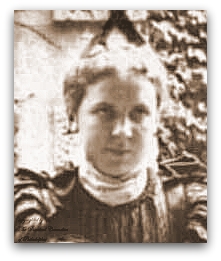 Miss Mary Joseph DailyMary Daily enjoyed her youth. In April 1896, when the little Thérèse, now a 23-year-old Carmelite nun at Lisieux, was entering into her trial against faith, Helen Kelly entered the Carmel of Boston at age 16. In December 1897, less than three months after Thérèse died of tuberculosis, Mary, then aged 20, followed her friend to the Boston Carmel, where she took the name Sister Mary of St. Joseph. The other nuns loved their humble, modest, and affectionate new sister.
Miss Mary Joseph DailyMary Daily enjoyed her youth. In April 1896, when the little Thérèse, now a 23-year-old Carmelite nun at Lisieux, was entering into her trial against faith, Helen Kelly entered the Carmel of Boston at age 16. In December 1897, less than three months after Thérèse died of tuberculosis, Mary, then aged 20, followed her friend to the Boston Carmel, where she took the name Sister Mary of St. Joseph. The other nuns loved their humble, modest, and affectionate new sister.
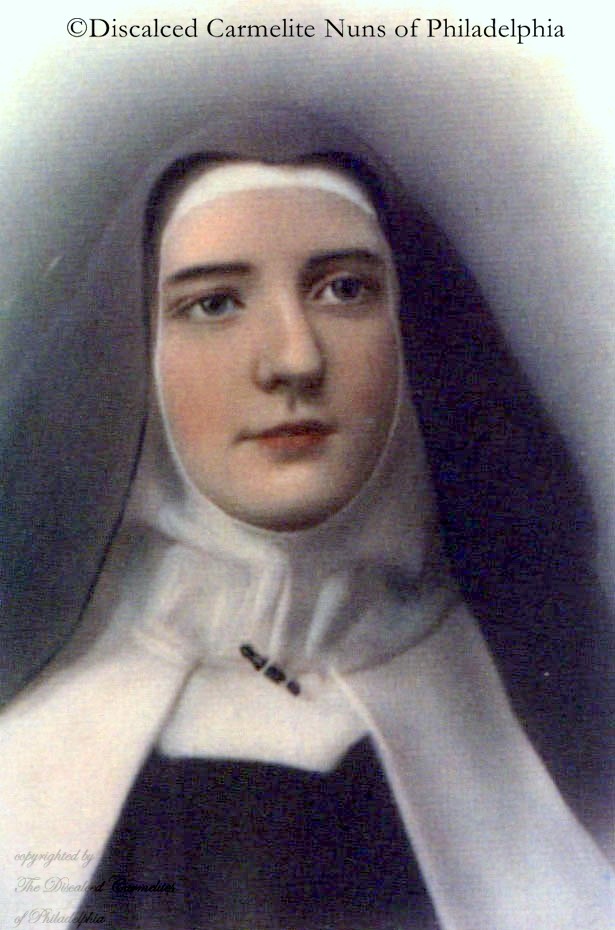 Sister Stanislaus of the Blessed Sacrament, O.C.D.
Sister Stanislaus of the Blessed Sacrament, O.C.D.
Sister Mary and Sister Stanislaus were living together in the Boston community when Thérèse’s Story of a Soul first appeared in French. A copy found its way to the Boston Carmel, and Sister Stanislaus translated it into English. In 1902, when both were chosen, along with three other nuns, to found a Carmel in Philadelphia, Sister Stanislaus was already a central figure in the American movement for the beatification of Sister Thérèse.
Sister Mary had been blissfully happy at the Boston Carmel, and accepting the move was not easy for her. On March 25, 1902, her 25th birthday, she had made a vow to be the lifelong servant of the Blessed Mother. She had a brave missionary spirit and a strong desire to partiicpate in the salvation of souls, and, in this spirit, she accepted everything.
But Sister Mary must have been happy to live closer to her family of origin. Carmel in Philadelphia: The First Hundred Years reproduces a photograph of Rose Daily and Mrs. H. Daily, presumably Mary’s mother and sister, kneeling in the public chapel of the first house on Poplar Street. In Philadelphia Sister Mary and Sister Stanislaus were assigned together as portresses, who answered the door and welcomed visitors and workmen to the monastery. Both seized on the opportunity this office gave them to spread devotion to Sister Thérèse among the people of Philadelphia. As early as 1910, Father Thomas Taylor, testifying at the diocesan process for Sister Thérèse, included the Carmel of Philadelphia in the list of places where Therese was loved. After Sister Stanislaus died in 1911, Sister Mary redoubled her efforts in the apostolate of making Sister Thérèse known. From a room in the old house before the present monastery was built, she ordered all kinds of materials from Lisieux, prepared catalogs, and distributed these items all over the United States.
 "Hill Top," the first house on the site of the Carmelite Monastery in Oak Lane, Philadelphia
"Hill Top," the first house on the site of the Carmelite Monastery in Oak Lane, Philadelphia
From that room she sent out $3,000 worth of materials related to Sister Thérèse. Sister Mary rejoiced to see Pope Pius X sign the decree introducing Thérèse’s cause at Rome on June 10, 1914.
God did not allow either of the two young women who had worked so hard to make Sister Thérèse known and loved to witness her canonization on earth. In the spring of 1915, Sister Mary, at age 38, showed signs of acute tuberculosis, the same disease from which Sister Therese died. Rest did little for her, so she continued her work until January 1916. Like St. Thérèse, she suffered acutely from fever, coughing, and nausea. She said these were signs that “Jesus is coming soon.” (During this period the Apostolic Process, at which witnesses testified about Sister Thérèse’s sanctity, was going forward in France; St. Thérèse’s novice, Sister Martha of Jesus, testified on Tuesday, February 8, 1916). On Friday, March 10, 1916, five years to the day after the death of her friend and fellow apostle, Sister Stanislaus, and two weeks before her thirty-ninth birthday, Sister Mary of St. Joseph was received into perfect union with her Divine Spouse.
I close by quoting from the booklet which furnished most of my information, Carmel in Philadelphia, The First 100 Years, written by Allan Dash and published by the Discalced Carmelite Nuns of Philadelphia in 2002:
“The two nuns were missionaries for souls, and had both made the Philadelphia Carmel a center of devotion to St. Thérèse by the early 1900s. They had knelt side by side for their first holy communion, and both went willingly to their eternal reward in the prime of life. They never saw the monastery they had come back to Philadelphia to build, but they left a legacy of personal holiness which became part of the foundation of the Oak Lane Carmel.”
May the Holy Spirit which moved these two young women to offer themselves as channels through which the grace of God drew so many souls to the Trinity move us, too, "to help souls." We rejoice to continue their apostolate today. Sister Stanislaus of the Blessed Sacrament, Sister Mary of St. Joseph, pray for us!
[My fervent thanks to the Discalced Carmelite Nuns of Philadelphia, who generously opened their archives to permit me to research this article. For more information, visit their site "The Discalced Carmelite Nuns of Philadelphia"].
The Carmelites of Lisieux in the Summer of 1944: 80 Days and 80 Nights in the Basilica of St. Therese. Written for the 70th anniversary of the liberation of Lisieux on August 23, 1944
by Joseph Ritson, of Great Britain, and Maureen O'Riordan
At the beginning of June, 1944, the French city of Lisieux, in the heart of the Normandy countryside. had been living under the Nazi Occupation for almost four years. During this time Lisieux and its population had been spared much of the devastation other French towns and cities had experienced. But Lisieux was a vital center of communication with Paris, and, when the Alllies launched their campaign to drive the Germans from France, they pounded Lisieux mercilessly with bombs. It would not be long until the people of Lisieux would see the German occupiers gone forever, but not before much suffering, death, and destruction came upon Lisieux.
D-Day, Tuesday, 6 June 1944 (in the evening)
The Allies bomb Lisieux at 8:30 p.m., aiming at the railroad yards. The raid lasted 30 seconds. The Carmelites were at evening prayer, and they continued their normal life as well as they could.
D + 1, Wednesday, 7 June 1944
A second, much bigger raid came at 2:00 a.m. during the night of June 6-7. Thousands of bombs destroyed many of the buildings in Lisieux. The Benedictine Abbey of Notre Dame due Pre, where Therese had been a student for five years and where she made her First Communion, had a direct hit. The souvenirs of Therese’s schooldays and of her First Communion disappeared. Sixty-three or more religious sisters in Lisieux died in the bombing. The number of deaths reported varied only slightly: contemporaneous accounts said that 21 Benedictines of the Abbey of Notre Dame du Pre, where Therese studied for five years; 20 Sisters of Providence, a nursing order; 10 Little Sisters of the Poor, who maintained a home for elderly men; 10 Sisters of Charity of the Refuge (a home for girls in trouble); and four Sisters of Notre Dame were killed.
Most buildings near the Carmel were destroyed. During the 2:00 a.m. raid, “while everything seemed crumbling and burning around them,” the Carmelite nuns gathered in little groups in the cells and prayed. Fire destroys the chaplain’s house at Carmel and the bookstore, Office Central, threatening the Carmel and the chapel.
At 2:00 p.m. a third aerial bombardment destroyed the esplanade of the Basilica and all the shops near the Basilica. Incendiary bombs fell in the courtyard of the Carmel, which “disappeared in a flash of flame and smoke."
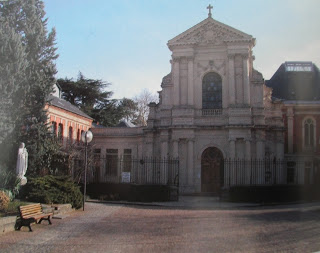
Carmelite Monastery, Lisieux. Photo credit: Joseph Ritson
The Carmelite nuns decide to remain in their cloister no matter what. But in the evening, the superior of the Mission de France urges Mother Agnes (the prioress, St. Therese’s sister Pauline) to lead the community to the Basilica, where the Carmel’s chaplains had already taken refuge. Mother Agnes at first feels that the nuns cannot leave the Carmel, but the whole city around the Carmel is burning, and the superior urges her not to stay there alone with the nuns, whose lives were in extreme danger; he says “You have only a few moments to decide.” Mother Agnes says “If it is our duty, we will do it.” The nuns took the Blessed Sacrament from their tabernacle and took it with them to the Basilica. Passing through the door, Mother Agnes blesses her Carmel with the sign of the Cross, and then leaves it for the first time since she had entered it 62 years before (October 2, 1882).
The nuns make their way through the devastation of Lisieux and up the hill to the Basilica of St. Therese. With the few other townspeople who had not evacuated, they shelter in the crypt. They take their place at the front of the crypt, on the right, before the statue of Our Lady of the Smile. They are surrounded by refugees and even by the wounded, whom the brave seminarians of the Mission of France had just dug out of the rubble. The number of refugees is about 80-100, of whom at least 40 were priests and nuns. At certain times in the summer, when refugees came form the countryside, there are more.
Later in the night, the roof of the house of the extern sisters at the Carmel is burned. There is a risk that the chapel containing the reliquary of St Thérèse might be destroyed by the fire. Then the direction of the wind suddenly changes. The chapel is spared. Some people attribute the saving of the chapel to the intercession of St Thérèse.
D + 2, Thursday, 8 June 1944
At daybreak, the fires of the night before are still burning. Most of the town has been evacuated, and few people are left to fight the fires. Priests and seminarians from the 'Mission de France' manage to extinguish the fires that threatened the Carmel. They rescue both the documents in the Carmel’s archive and the reliquary of St Thérèse, and transport them to the Basilica.
Many civilians from Lisieux and its surroundings seek shelter in the Basilica.
The weekend of Saturday 10 June and Sunday 11 June 1944
During the nights of June 10 and June 11, the Allies bomb Lisieux again. The Carmelite monastery and garden are slightly damaged. Three or four Masses are offered in the Basilica every morning all summer, with rosary and Benediction in the evening. In their corner of the crypt, the Carmelites continue to recite the Divine Office.
D + 7, Tuesday, 13 June 1944
A message reaches Mother Agnes from Emmanuel Cardinal Suhard, archbishop of Paris, stating that on May 3, 1944, Pope Pius XII had declared St. Therese secondary patron of France. (St. Joan of Arc is the other secondary patron. The principal patron of France is the Blessed Virgin). To their evening prayer the nuns add the invocation (in Latin): “St. Therese, patron of France, pray for us.”
June and July 1944
The Allies continue to bomb Lisieux and its environs. More civilians seek shelter in the Basilica.
Tuesday, 11 July 1944
By July 11, about three-quarters of the buildings in Lisieux had been destroyed. The priests and nuns in the crypt of the Basilica organize a novena to ask for the intercession of St Thérèse.
Wednesday, 12 July 1944
The first day of the novena to St Thérèse.
Sunday, July 16, 1944
In the crypt, Mother Agnes receives the vows of a young Carmelite nun.
On various days when the military situation permitted it, Mother Agnes visits the Carmel several times to inspect it. She and Sister Genevieve also visit the town cemetery to pray before the tombs of their parents, other members of the family, and other Carmelites. They pray near the spot where Therese’s body had been buried before its return to Carmel in 1923.
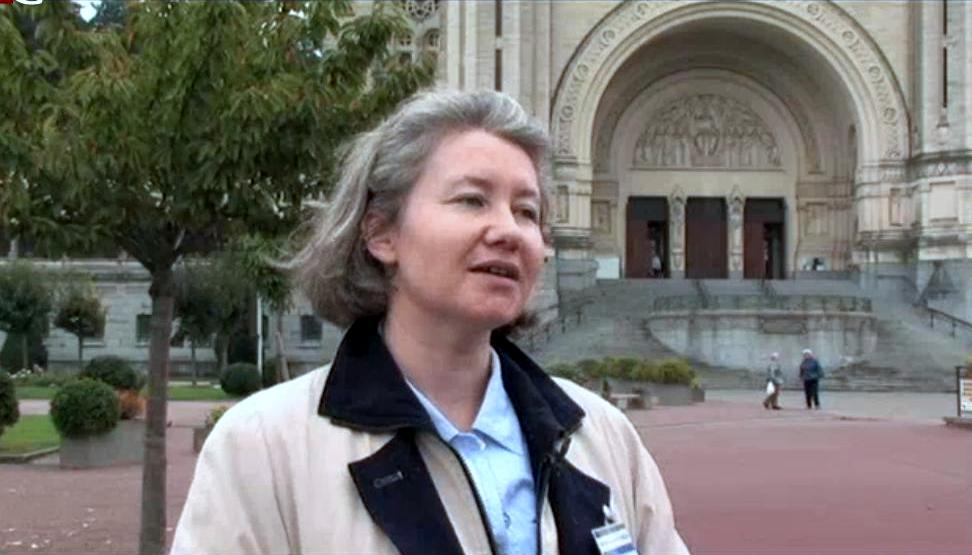
Mgr Germain, Director of Pilgrimages, invites the saint’s sisters to climb up to the cupola of the Basilica to see what remains of the town. Mother Agnes, at 82, surprises everyone by climbing fastest of all.
Thursday, 20 July 1944
The Basilica is crowded with refugees, including those from nearby villages. Many had already seen their homes and churches destroyed. The clergy make a vow that, if they are delivered, each year they will bring the relics of St. Therese in procession from St. Pierre’s Cathedral to the Basilica. Since the end of the war, this procession has taken place every year on the feast of St. Therese.
Sunday, 6 August 1944
A “perpetual rosary” begins in the crypt of the Basilica. It continues until August 27. At every moment at least three persons were praying this rosary,.
Monday, 7 August - Tuesday, 15 August 1944
In early August 1944 the 'Secours National' (National Relief) offers to transport the Carmelite nuns by truck to Paris. There was talk of a forced evacuation of Lisieux. Reluctant to leave the townspeople, the Carmelites organize a novena of adoration to help them decide. Mother Agnes invites them to pray fervently for light. She gives permission to any Sisters who might want to leave, but they all decide to stay and wait for the outcome of the battle for Lisieux. To prepare for the Feast of the Assumption on August 15, a second general novena is organized in the crypt to pray for the deliverance of Lisieux, the end of the war, and the coming of peace.
Wednesday, 16 August 1944
In Rome, the Pope requests that the religious buildings of Lisieux be respected. The German 'Kommandatur' asks the civil authorities for precise details about the buildings. For some unknown reason, the 'Kommandatur' suddenly leaves, never to return!
Saturday, 19th August 1944
The battle for Lisieux begins in earnest. Artillery fire is aimed at Lisieux. One artillery shell hits the wall of the Carmelite cloister. The doors and windows of the monastery are blown in, and the roof is blown off the wash house.
Monday, 21 August 1944 - Wednesday, 23 August 1944
The battle for Lisieux.
On the night of August 21-22, about 200 German soldiers arrive at the Basilica asking for a place of peace for a few hours so they can sleep. The crypt is crowded with civilian refugees, and the Germans are directed to the upper part of the Basilica.
Tuesday, 22 August 1944 (evening)
The first Allied tanks arrive. They meet strong and determined resistance from German machine guns positioned in the town square. The two sides exchange fire. Some German artillery shells fall in the yard which gives access to the crypt. The religious community and the civilans fear that the Basilica may be destroyed in the fighting. Nevertheless, they continue to pray for deliverance and for the intercession of St Thérèse. One of the Carmelites, Sister Anne of Jesus, writes, on September 8, 1944, this description: “The final battle lasted for 48 hours, and we were between the two fires. I cannot tell you what an uproar it was. It was sinister. Finally on August 25 the last Germans left, and we were able to breathe a little easier . . . .”
Wednesday, 23 August 1944 (evening)
One way or another, the end is in sight with the arrival of British troops. They ask to set up an observation post from the lantern inside the dome of the cathedral and also to install a machine gun. However, this position is abandoned within a few hours as the Germans have departed.
After 48 hours of fierce fighting Lisieux had finally been delivered! Liberation at last and the Basilica has remained largely unharmed.
According to the Basilica archives, the saving of the Basilica from further damage is attributed to Major George Warren of the 1/6 Battalion, Queen's Royal Regiment:
"The Basilica, it was to be knocked down! We were given the order to destroy it because we were told it was protecting Germans. It was already aimed at when we were guaranteed that there were no soldiers. Not wanting to foolishly destroy such a monument we asked on numerous occasions to check if there were no troops hiding here. There was a counter-order but you were very lucky!”
Sunday, 27th August 1944
At the Basilica there is a religious ceremony of thanksgiving. Afterwards, Mother Agnes and the Carmelite nuns, carrying the coral trunk with the relics of St. Therese, return in procession across the ruins of the liberated city to their monastery. They are accmpanied by a crowd of the lay persons with whom they had lived for eighty days and eighty nights. The relics of St. Therese are restored to the chapel.
All the Carmelites of Lisieux survive the battle. Their monastery is slightly damaged, but not destroyed. Les Buissonnets, St. Therese’s family home, remains intact.
The Carmelite nuns return to their usual monastic way of prayer and silence. With the ending of the Battle of Normandy and the liberation of France, many more people from the surrounding countryside come to Lisieux to give thanks for their deliverance.
[Note: Part of this article is drawn from information in Joseph Ritson's "The Deliverance of Lisieux in August 1944." Sources included the Tourist Information Office at Lisieux; the Pilgrimage Office at Lisieux; and the Carmelite Monastery at Lisieux. Information for this 70th anniversary article was also drawn from documentation furnished by the Carmelite Monastery of Philadelphia; from Celine: Sister and Witness of St. Therese of the Child Jesus by Stephane-Joseph Piat, O.F.M. (San Francisco: Ignatius Press, 1997); and from the sites listed as references to this blog entry. Our sincere thanks to all those who furnished information].
163 photographs of Lisieux after the bombing of June 1944
Thanks to the Mediatheque de Lisieux and Photos Normandie, we can mark the 70th anniversary of the liberation of Lisieux (August 23, 1944) with this show of 163 photographs of Lisieux taken after the bombing of June 1944. See several photos of the ruins of the Benedictine Abbey where Therese made her First Communion; photos of the rue du Livarot, on which the Carmel is located; and the destruction of three-quarters of the city. These photos give you an idea of the horrific destruction and of the ruins seen by Therese's sisters and the other Carmelites when, on the evening of June 7, 1944, they were obliged to leave their monastery and climb up to the Basilica to seek refuge, with other civilians,in the crypt. May these images of destruction inspire us to pray for peace today.
St. Therese of Lisieux and Sister Stanislaus of the Blessed Sacrament, "Philadelphia's Little Flower"- Part 1 - August 21, 2014
Leading up to the first presentation of the new conference "The Martin Family and the Lisieux Carmel, and St. Therese and the Carmel of Philadelphia" on September 7, 2014, we are featuring a series of "teaser" articles about the remarkable personalities who participated in the extraordinary outpouring of devotion to St. Therese that was born at the Philadelphia Carmel from its foundation in 1902, five years after the death of Therese. We introduce the series with part one, "St. Therese of Lisieux and Sister Stanislaus of the Blessed Sacrament (1879-1911)," who came to be known as "Philadelphia's Little Flower."
 Sister Stanislaus of the Blessed Sacrament, O.C.D.
Sister Stanislaus of the Blessed Sacrament, O.C.D.
The young nun who established the first contact between the Philadelphia Carmel and the Lisieux Carmel, and who maintained it for many years, was Sister Stanislaus of the Blessed Sacrament, one of the remarkable group of young women who came to be known as the “four foundresses” of the Philadelphia Carmel.
The future Sister Stanislaus was born in Philadelphia on June 6, 1879 to Francis and Mary Therese Kelly and baptized Helen Genevieve. (At that time little Therese Martin, almost six and a half years old, had been living in Lisieux, where her family moved after the death of her mother, for less than two years). The resemblance between Helen's life and that of St. Therese is striking. Like St. Therese, she was the youngest of a large family (thirteen children!) Like Therese, she had two sisters who also became nuns (Sisters of Charity). She was also granted what Therese and her parents, Louis and Zelie Martin, had long desired: a priest brother, Father Joseph Kelly.
Lively and playful as a child, Helen was educated by the Sisters of Notre Dame de Namur and had ties to the Church of the Gesu, a now-closed parish in North Philadelphia which was then staffed by Jesuits. Like Therese, Helen experienced the call to Carmel early. Years before Helen was born, the future St. John Neumann, bishop of Philadelphia, had wanted to establish a monastery of Discalced Carmelite nuns in this diocese. With the echo of the Know-Nothing riots of the 1840s still in their ears, his council had persuaded him against it. In Helen’s youth, then, no Carmelite monastery existed in Philadelphia. But in 1895, while Sister Therese of the Child Jesus was writing her first memoir at the Carmel of Lisieux, another young Catholic woman of Philadelphia, Mary Otillia McGeogh, had entered the Carmel in Boston. It was to this Carmel of Boston that Helen applied at age sixteen. She so impressed the community that they waived the rule (as the Lisieux Carmel had done for Therese) and allowed her to enter at seventeen. She was received in April, 1896, the very month in which, “during those very beautiful days of the Easter season,” Therese first began to experience her trial against faith.
Lisieux Carmel also had a Sister Stanislaus
Another synergy between Stanislaus and Therese: the Lisieux Carmel also had a Sister Stanislaus, this time Sister Stanislaus of the Sacred Hearts, a goodhearted elderly nun who, for several years, supervised the young Sister Therese when she worked in the sacristy. It was for Sister Stanislaus’s jubilee that Sister Therese wrote her last religious play, “St. Stanislaus Kostka,” about the young Polish Jesuit who died, while still a novice, at age seventeen—the age at which Sister Stanislaus of the Blessed Sacrament of Philadelphia entered the Carmel in Boston. Perhaps the name “Stanislaus” was chosen for her because she was the same age as the young Jesuit saint.
Sister Stanislaus of the Blessed Sacrament Meets St. Therese in Boston
Sister Stanislaus was still in her early religious formation at the Boston Carmel when Sister Therese died in Lisieux on September 30, 1897. A little more than a year later, the memoir of the young French nun who had died at age 24 was published as Histoire d’une Ame, in an edition of 2,000 copies. One of them found its way to the Boston Carmel, where Sister Stanislaus read it eagerly. She began at once to translate it into English. Her life would never be the same.
Her childlike simplicity and purity of heart were wings with which she flew in the wake of the Little Flower. In Therese she found her soul’s companion and guide for the fulfillment of her own holy desires and longings.
When she became a foundress of the Philadelphia Carmel in 1902, she already had become a central figure in the American campaign to beatify the future saint, and she remained devoted to this effort as long as she lived.
(Carmel in Philadelphia: The First Hundred Years (published by the Discalced Carmelite Nuns of Philadelphia, 2002), p. 54.
Sister Stanislaus Was a Pioneer in Making Sister Therese Known
That Sister Stanislaus, as early as 1902, was central to the "American effort to beatify Therese" is the more significant when one realizes that the word "beatify" is not known to have been mentioned in France until 1903, when Fr. Thomas Taylor of Scotland first visited the Lisieux Carmel and urged Therese's sisters and Mother Marie de Gonzague, who received him in the speakroom, to open her cause. At the diocesan process in 1910 Fr. Taylor testified that Therese's reputation developed slowly at first (at least until 1908). When he visited the Blackrock Carmel of Dublin in 1904, "before the great movement of devotion that has developed since then," the prioress laughed at the idea of canonizing Therese and said "We may as well canonize all the Carmelite nuns." (She changed her mind later). He said that after a favor received at the Good Shepherd Convent in London in 1908, Sister Therese's reputation "has greatly developed, especially in Scotland." (Testimony of Fr. Thomas Nimmo Taylor at the 1910 Process for St. Therese on the Web site of the Archives of Lisieux).
After the arrival of the four foundresses, Philadelphia would never be the same.
[Continue to part two of this series, "Letters from St. Therese's sister Pauline, Mother Agnes of Jesus, to Sister Stanislaus of the Blessed Sacrament, "Philadelphia's Little Flower"]
[Continue to part three of this series, "St. Therese of Lisieux and Sister Mary of St. Joseph," which recounts the efforts of Sister Stanislaus’s childhood friend and fellow apostle, Sister Mary of St. Joseph, to make the spirituality of St. Therese known and loved].
To learn more, visit the Web site of "The Discalced Carmelite Nuns of Philadelphia." I thank the nuns for generously allowing me to use the publication listed above and the documents in their archives (digitized on their Web site!)].